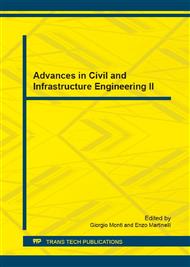p.191
p.204
p.210
p.222
p.233
p.240
p.248
p.257
p.266
A Direct Five-Step Procedure for the Dimensioning of Viscous Dampers to Be Inserted in Frame Structures
Abstract:
Many design methods for the design of viscous dampers to be inserted in building structures are available in the scientific literature and building codes. Among others, the authors proposed a five-step procedure guiding the practioner from the choice of a target reduction in the seismic response of the structural system (with respect to the response of a structure without any additional damping devices), to the identification of the corresponding damping ratio and the mechanical characteristics of the commercially available viscous dampers. The original procedure required the development of numerical simulations for the evaluations of the peak inter-storey velocity profiles, necessary for the evaluation of the non-linear damping coefficient. More recently, a fully analytical version of the 5-step procedure (direct) has been also introduced. In the present work, an application of the direct procedure for a three-storey school building is presented.
Info:
Periodical:
Pages:
233-239
Citation:
Online since:
July 2016
Authors:
Price:
Сopyright:
© 2016 Trans Tech Publications Ltd. All Rights Reserved
Share:
Citation:


